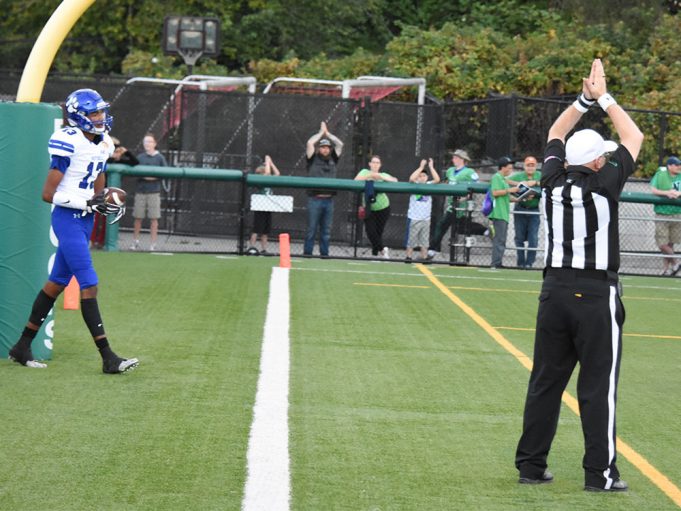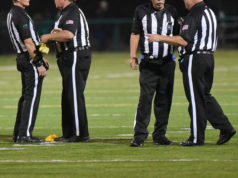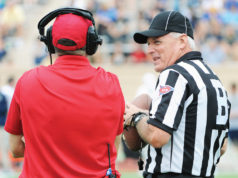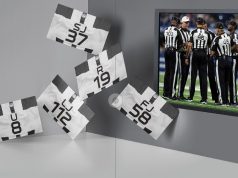The opening kickoff sails over the goalline. The ball is muffed in flight by the receiver and rolls away. The ball is recovered and the run attempt ends with a tackle within the end zone. What’s the ruling?
One pregame discussion for a junior college game was extended for 30 minutes because one official had difficulty accepting the notion this play results in a touchback, not a safety. In a prep game, the result is also a touchback, but the ball would be whistled dead once it broke the plane of team R’s goalline (NFHS 6-3-1a; NCAA 8-6-1a).
The key to determining whether the result of a play is a safety or touchback is the force (NFHS 2-13-1) or impetus (NCAA 8-7-1) that caused the ball to go from the field of play into the end zone. Force and impetus connote the same idea: the energy that causes movement of the ball. For ease of reference, force will be used from this point forward. Unless otherwise noted, the material is identical for both NFHS and NCAA rules.
Force is of significance only when the ball crosses the goalline and only when it goes from the field of play into the end zone.
The initial force results from a carry, fumble, kick, pass or snap. A new force cannot be imparted to a ball in flight, but once it is grounded a new force may result from a bat, illegal kick or muff. Merely touching, deflecting or being struck by a ball does not provide a new force. When the ball is at rest or nearly at rest, almost any contact will cause a new force. When a player pushes or blocks an opponent into a ball, the contact is ignored. For grounded balls, the covering official in NFHS must decide whether the ball would have gone into the end zone without the subsequent contact. However, in NCAA play, a muff is not a new force unless the ball is at rest; a new force does result when a grounded loose ball is batted or illegally kicked.
For a safety to occur, a team must put the ball into its own end zone. A touchback can occur when a team puts the ball into its opponent’s end zone.
Safeties.
A safety scores two points for the opponents and the team whose goalline is involved must then put the ball in play on its 20 yardline by a free kick. The most common way to incur a safety is for a runner to carry the ball across his goalline where it becomes dead while still in possession of the same team. By definition, the dead-ball spot is the spot under the foremost point of the ball, but there is one exception.
Play 1: Second and 15 on team A’s two yardline. A1 receives a handoff in team A’s end zone and is tackled with the foremost point of the ball six inches beyond the goalline and the rear part of the ball on the goalline. Ruling 1: Score a safety for team B. If any part of the ball is touching the goalline when it becomes dead, the ball is in the end zone, even though its foremost point is beyond the goalline.
In the following play, although team R changes the direction of the ball, the initial force is not changed because the ball was in flight when team R contacted it.
Play 2: Fourth and 10 on team K’s five yardline. K1’s punt from team K’s end zone is muffed in flight by R2 at team K’s 10 yardline and rebounds into team K’s end zone, where it is recovered by a prone K3. Ruling 2: Safety. The force that put the ball in the end zone was K1’s kick. A new force cannot be imparted to a ball in flight.
Safeties by penalty.
If the enforcement spot is in the offending team’s end zone, the penalty results in a safety (NFHS 8-5-2c; NCAA 8-5-1b).
Play 3: First and 10 on team A’s four yardline. A1 completes a pass to A2 at team A’s 20 yardline. A3 is flagged for holding in team A’s end zone. Ruling 3: Since the foul occurred in the end zone, the penalty yields a safety.
In the preceding play, all-but-one enforcement applies in NFHS. The foul by A3 occurred behind the basic spot and is enforced from the spot of the foul. Under NCAA rules, all-but-one enforcement does not apply for team A contact fouls that occur behind the neutral zone. Illegal use of hands, holding, illegal blocks and live-ball personal fouls are enforced from the previous spot. However, there is an exception when the foul is in the end zone, so the foul results in a safety.
Illegal touching.
It is illegal touching if an originally ineligible receiver intentionally touches a legal forward pass before it is touched by an opponent. Touching by an ineligible does not excuse intentional grounding or pass interference. Here’s how a safety could result.
Play 4: Third and 10 on team A’s six yardline. A1 drops back to pass. From deep in the end zone, A1 throws a forward pass to ineligible A2, who muffs the ball in the end zone. The pass falls incomplete. Ruling 4: Illegal touching. In NFHS, the enforcement spot is where A2 muffed the ball. The result is a safety. Under NCAA rules, the penalty is enforced from the previous spot and includes a loss of down. It will be fourth and 13 on team A’s three yardline.
Momentum exception.
The momentum rule is an exception to force and a team may be excused from a safety. When a team B or team R player secures a loose ball inside his five yardline and momentum takes him into the end zone, and the ball becomes dead there, the ball is returned to the spot where possession was gained.
It’s important for officials to recognize a momentum situation and to beanbag the spot where possession is gained. For the exception to apply, original momentum must be the cause of the ball entering the end zone. If the covering official judges the player voluntarily carried the ball across the goalline, regular rules apply and the play may result in a safety.
What happens after the ball enters the end zone is almost always inconsequential, providing the ball never leaves the end zone and team B or team R has possession at the end of the down.
How does a foul affect the momentum exception?
Play 5: Fourth and 10 from team R’s 43 yardline. R1 catches a punt on team R’s four yardline and momentum carries him into the end zone where the tackle is made. After the catch and while the ball was still live, R2 clipped K3 (a) in the end zone or, (b) at team R’s 15 yardline. Ruling 5: Because the momentum exception applies, the end of R1’s run is considered to be the spot where the kick was caught (team R’s four yardline) and that is the basic spot. In (a), the enforcement results in a safety since the foul by the receiving team occurred behind the basic spot and the spot of the foul is in the end zone. In (b), the penalty is enforced half the distance from the basic spot to team R’s two yardline, where it will be first and 10 for team R (NFHS 8-5-2a Exc., 10-4-3, 10.4.3C; NCAA 2-25-11, 8-5-1b Exc., AR 8-5-1 VII).
Here’s a play in which momentum is involved but the exception doesn’t apply.
Play 6: First and 10 for team A from its six yardline. A1 muffs a backward pass at the two yardline. The ball pops up into the air and is caught by A2, who lunges for the ball from the vicinity of the two yardline. A2’s momentum carries him into the end zone, where he falls to the ground. Ruling 6: Team A remains the offensive team throughout the down. Consequently, the momentum exception does not apply. The play results in a safety (NFHS 8-5-2a Exc.; NCAA 8-5-1b Exc.).
Fumbles.
If the momentum exception applies and the player in possession in the end zone fumbles, and the fumble goes out of bounds in the end zone, it belongs to the fumbling team at the momentum spot. If, after securing possession, the player fumbles from within the end zone and the ball goes forward and out of bounds between the goallines, in NFHS, the ball belongs to the fumbling team at the spot it went out of bounds. In NCAA, the ball returns to the end zone and is awarded at the momentum exception spot (NFHS 8-5-2a Exc., 10-3-3c, 8.5.2F; NCAA 8-5-1 Exc., AR 7-2-4 I, AR 8-5-1 V).
What's Your Call? Leave a Comment:
Note: This article is archival in nature. Rules, interpretations, mechanics, philosophies and other information may or may not be correct for the current year.
This article is the copyright of ©Referee Enterprises, Inc., and may not be republished in whole or in part online, in print or in any capacity without expressed written permission from Referee. The article is made available for educational use by individuals.



















